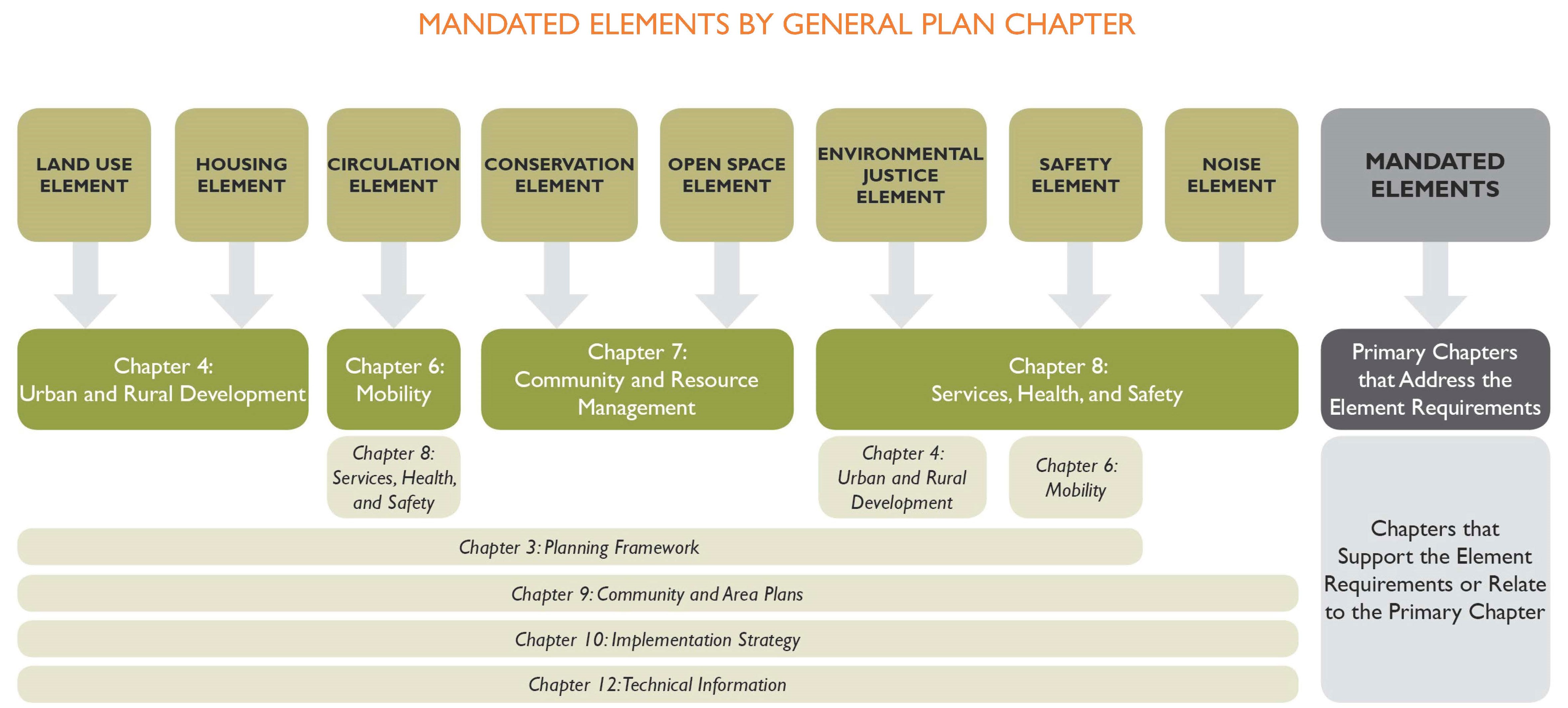General Plan (Policy Document)
Below are links to General Plan policy document. The document is organized into 12 chapters, which cover the content required by State law. The structure of the General Plan can best be summarized in the following graphic.

Please note, the General Plan utilize a "spread format" where some graphics span across both the left and right pages when printed double sided. The PDFs linked below are correctly viewed in a browser in a Two-Page layout view, if your browser supports this function. Should you choose to print the document, please select your printer's double-sided function (if available). A hard copy of the General Plan is available for review at City Hall.
Complete Document
- Complete General Plan (reflects amendments through December 2023)
Interactive General Plan Maps
- View interactive versions of the maps from the General Plan (Update Pending)
Sections (Reflects Amendments through December 2023)
- Cover and Table of Contents
- Chapter 1: Introduction
- Chapter 2: Vision
- Chapter 3: Planning Framework
- Chapter 4: Urban and Rural Development
- Chapter 5: Economy and the Region
- Chapter 6: Mobility
- Chapter 7: Community Resource Protection
- Chapter 8: Services, Health, and Safety
- Chapter 9: Community and Area Plans
- Chapter 10: Implementation Strategy
- Chapter 11: Glossary and Acronyms
- Chapter 12: Technical Appendix
Environmental Impact Report
The California Environmental Quality Act requires the City to prepare an Environmental Impact Report (or EIR) on the General Plan. The EIR documents the potential environmental impacts of the General Plan and informs the City Council, Planning Commission, and general public of these potential impacts. Were applicable, mitigation measures may be identified to reduce the potential impact to a less than significant level.
The EIR is made up of several documents, which are:
- The Draft EIR, which is prepared and circulated for public comment.
- The Final EIR, which includes responses to comments on the Draft EIR and an errata list of changes to the EIR.
- The Findings of Fact and Statement of Overriding Considerations
- A Mitigation Monitoring and Reporting Program
Final EIR Document
Other Documents
Draft EIR Document
Sections
- Cover and Table of Contents
- Executive Summary
- 1.0 Introduction
- 2.0 Project Description
- 3.0 Demographics
- 4.0 Land Use
- 5.0 Introduction to the Environmental Analysis and Assumptions Used
- 5.1 Aesthetics
- 5.2 Agricultural Resources
- 5.3 Air Quality
- 5.4 Biological Resources
- 5.5 Cultural Resources
- 5.6 Geology, Soils, Mineral Resources, and Paleontology
- 5.7 Greenhouse Gas Emissions and Energy
- 5.8 Hazards and Hazardous Materials
- 5.9 Hydrology and Water Quality
- 5.10 Noise
- 5.11 Public Services and Recreation
- 5.12 Public Utilities
- 5.13 Transportation
- 6.0 Other CEQA Considerations
- 7.0 Project Alternatives
- 8.0 Report Preparation
Appendices
Climate Action Plan
The Climate Action Plan identifies how the City will achieve State-recommended targets of reducing greenhouse gas (GHG) emissions. The Climate Action Plan, or CAP, was first adopted in 2013 and has been updated concurrently with the General Plan Update.
- Climate Action Plan (updated December 2022)
Transportation Analysis Guidelines
The Transportation Analysis Guidelines present a clear and consistent technical approach to transportation analysis for projects within Elk Grove. They implement the General Plan policies for mobility and circulation by providing instructions for the preparation of transportation analysis. This document replaces the prior Traffic Impact Study Guidelines.
- Transportation Analysis Guidelines (updated December 2023)
Park Design Principles
The Park Design Principles provide criteria to guide individual park master planning efforts. The Principles address the community's desire for non-programmed spaces by reallocating programmed sports fields from local and neighborhood parks to larger community parks. The Park Design Principles were prepared by Cosumnes Community Services District as part of their 2018 Parks Master Plan Update and concurrently adopted by the City.
- Park Design Principles
- Plan for Plan: Parks, Recreation, and Facilities Master Plan (links to CCSD website)
Local Hazard Mitigation Plan
The Disaster Mitigation Act of 2000 requires communities to prepare and maintain an updated Local Hazard Mitigation Plan (LHMP) recognizing potential natural hazards and to identify and consider mitigation measures to reduce the risks associated with such hazards. The LHMP is a tool to guide land use planning and is required for participating jurisdictions to remain eligible for federal hazard mitigation funding from the Federal Emergency Management Agency (FEMA). The Plan must be updated approximately every five years and final acceptance of the Plan by FEMA is contingent upon adoption by the local jurisdiction’s governing body. State law requires that the LHMP be included by reference in the General Plan (this reference can be found in Chapter 8) and a link to the document provided on the General Plan website (below).
The LHMP is prepared in partnership with Sacramento County and the other cities and special districts in the County. More details are available on the County website.
General Plan Annual Report
State law requires each jurisdiction to complete an Annual Report on the General Plan that is submitted to the local planning agency (the City Council), to the State Office of Planning and Research, and to the State Department of Housing and Community Development (California Government Code Section 65400). This report must:
- Identify compliance with the State General Plan law and State General Plan Guidelines;
- Identify status of the General Plan and the process towards its implementation;
- Describe the City's progress in meeting its Regional Housings Needs Allocation;
- Describe progress in addressing/removing governmental constraints to the maintenance, improvement, and development of housing; and
- Identify any surplus lands within the jurisdiction.
State law requires that the General Plan Annual Report be complete and submitted by April 1 of each year.

